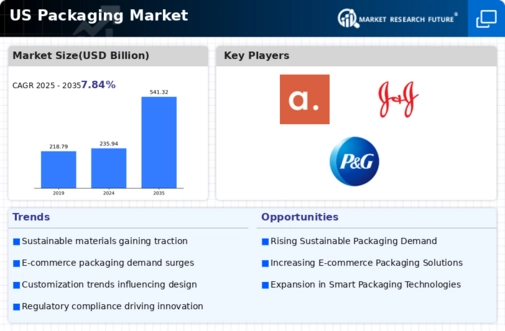E-commerce Growth
The rise of e-commerce in the US has a profound impact on the packaging market. As online shopping continues to expand, the demand for efficient and protective packaging solutions increases. In 2025, e-commerce sales are projected to reach approximately $1 trillion, necessitating innovative packaging designs that ensure product safety during transit. This shift towards online retailing drives companies to invest in packaging that is not only functional but also visually appealing to enhance customer experience. The packaging market must adapt to these changing consumer behaviors, focusing on lightweight materials that reduce shipping costs while maintaining product integrity. Furthermore, the need for sustainable packaging options is becoming increasingly important as consumers demand eco-friendly solutions. Thus, the growth of e-commerce is a significant driver for the packaging market, pushing for advancements in design and materials.
Regulatory Compliance
Regulatory compliance is a critical driver in the packaging market, particularly in the US. Various federal and state regulations govern packaging materials, labeling, and safety standards. For instance, the Food and Drug Administration (FDA) imposes strict guidelines on packaging for food and pharmaceutical products to ensure consumer safety. Companies must invest in compliant packaging solutions to avoid legal repercussions and maintain market access. In 2025, it is estimated that compliance-related costs could account for up to 10% of total packaging expenses for certain industries. This necessitates ongoing research and development to create packaging that meets regulatory standards while also being cost-effective. As regulations evolve, the packaging market must remain agile, adapting to new requirements and ensuring that products are safely packaged and labeled. This dynamic environment presents both challenges and opportunities for innovation within the industry.
Sustainability Demands
Sustainability demands are increasingly shaping the packaging market in the US. Consumers are becoming more environmentally conscious, leading to a heightened demand for sustainable packaging solutions. In 2025, it is estimated that the market for sustainable packaging will reach $300 billion, driven by consumer preferences for recyclable, biodegradable, and compostable materials. Companies are responding by re-evaluating their packaging strategies, seeking to reduce waste and minimize their carbon footprint. This shift is not only a response to consumer demand but also a proactive approach to regulatory pressures aimed at reducing plastic waste. The packaging market is witnessing a surge in innovation as companies explore alternative materials and design practices that align with sustainability goals. This focus on sustainability presents both challenges and opportunities, as businesses must balance cost, functionality, and environmental impact in their packaging solutions.
Technological Integration
Technological integration is a pivotal driver in the packaging market, influencing how products are packaged and delivered. Innovations such as smart packaging, which incorporates sensors and QR codes, are becoming more prevalent. These technologies enhance consumer engagement and provide valuable information about product freshness and usage. In 2025, the smart packaging segment is expected to grow at a CAGR of 15%, reflecting the increasing adoption of technology in packaging solutions. Additionally, automation in packaging processes is streamlining production, reducing costs, and improving efficiency. Companies are investing in advanced machinery and software to optimize their packaging lines, which can lead to significant savings. As technology continues to evolve, the packaging market must adapt to these advancements, ensuring that products not only meet consumer expectations but also leverage new technologies for competitive advantage.
Consumer Preferences for Convenience
Consumer preferences for convenience are reshaping the packaging market in the US. As lifestyles become increasingly fast-paced, there is a growing demand for packaging that offers ease of use and portability. Products that feature resealable, single-serve, or easy-to-open packaging are gaining popularity among consumers. In 2025, it is projected that convenience-oriented packaging will account for approximately 30% of the total packaging market. This trend is particularly evident in the food and beverage sector, where ready-to-eat meals and snacks are on the rise. Companies are responding by designing packaging that not only meets these convenience needs but also aligns with sustainability goals. The challenge lies in balancing functionality with environmental considerations, as consumers are also seeking eco-friendly packaging solutions. Thus, the drive for convenience is a significant factor influencing the evolution of the packaging market.














Leave a Comment